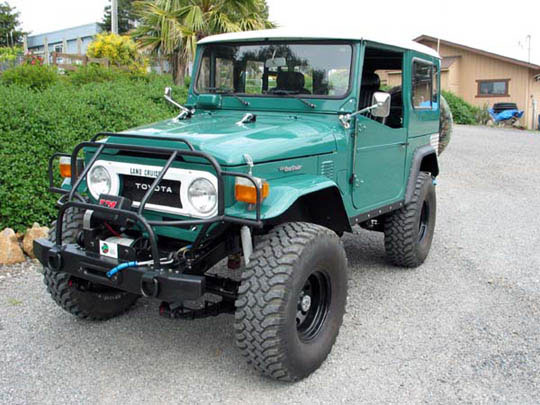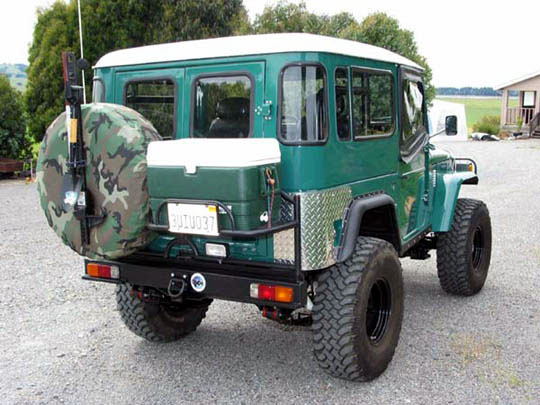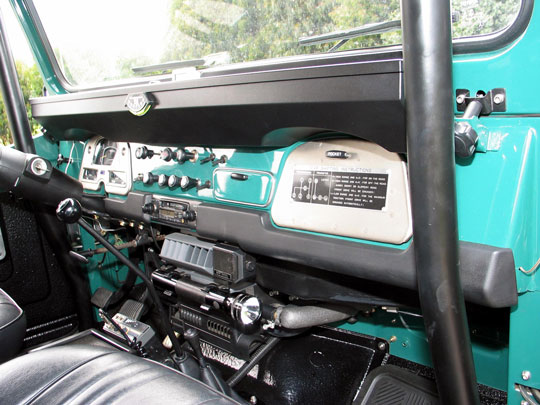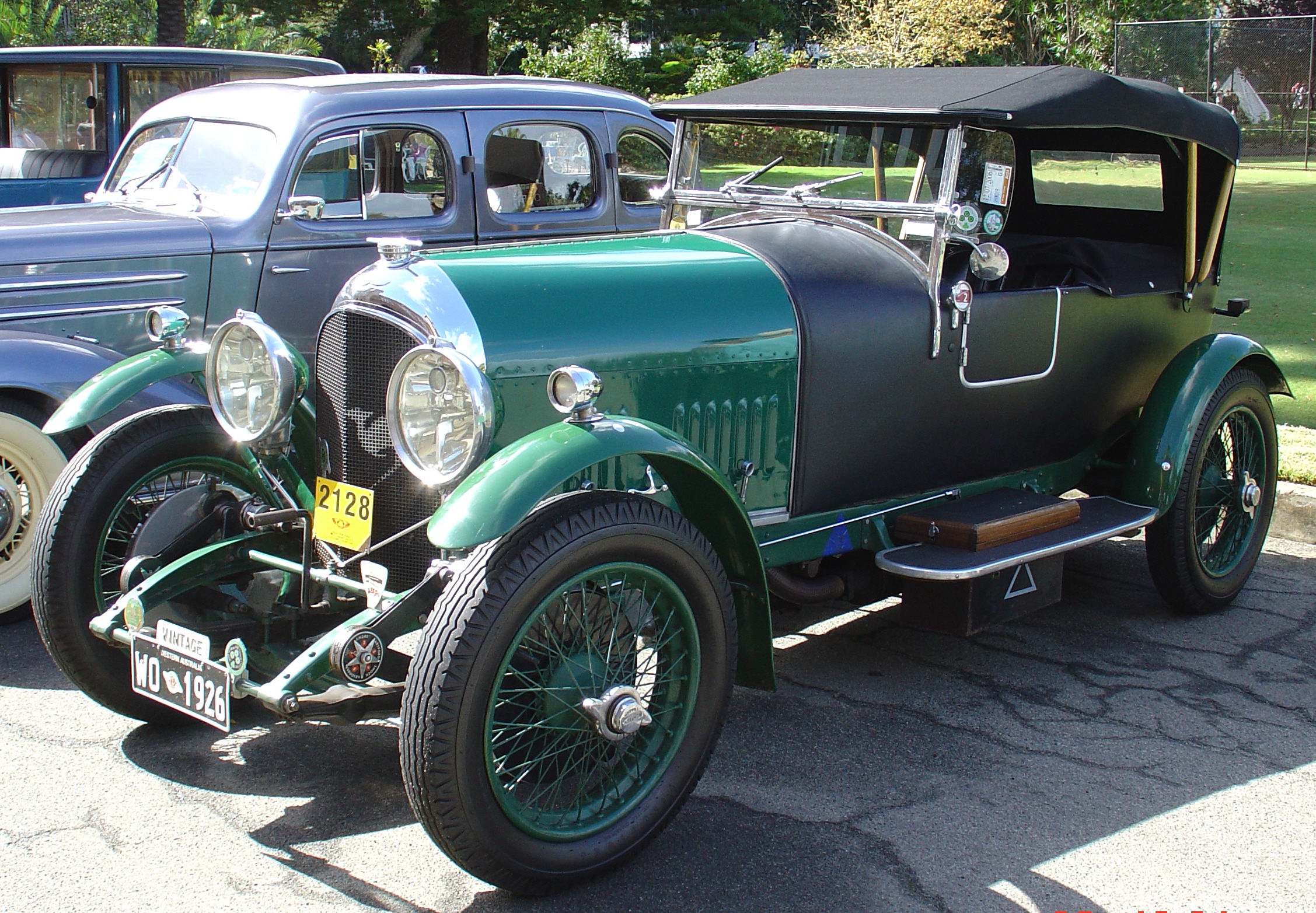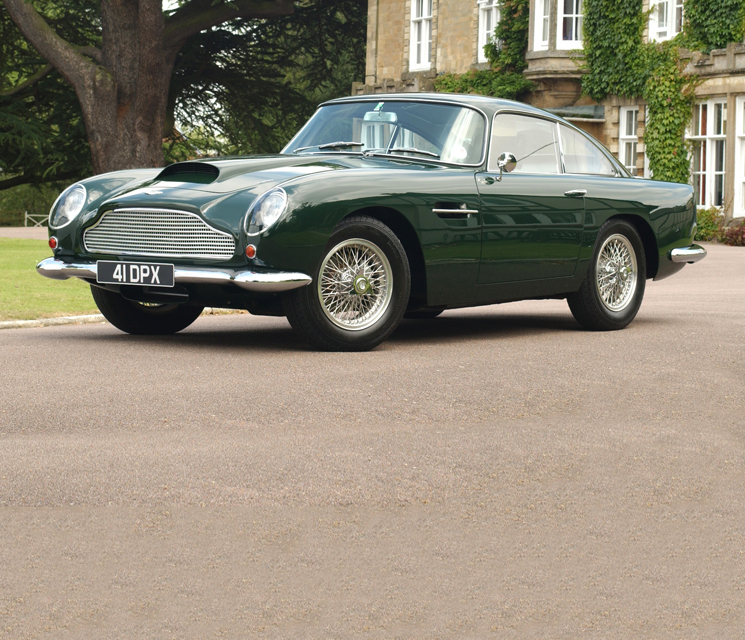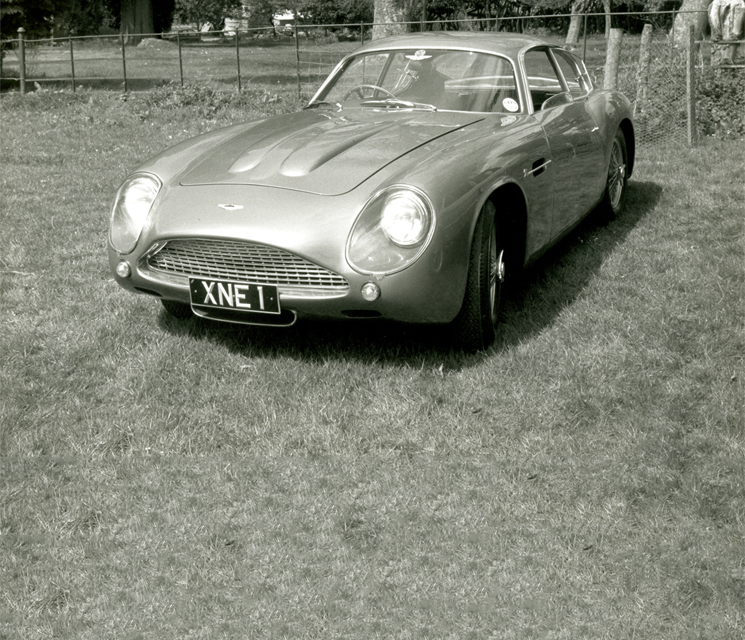Wednesday, October 31, 2012
BMW Dixi 3/15 DA-1 & DA-2
1927
BMW Dixi 3/15 DA-1
1929
BMW 3/15 DA2
BMW Dixi 3/15 DA-1
1929
BMW 3/15 DA2
Monday, October 29, 2012
Toyota Land Cruiser FJ40 (1960-1984)
Toyota Land Cruiser FJ40
(1960-1984)
(1960-1984)
Labels:
1960-1969,
1970-1979,
1980-1989,
All Makes,
Classic Car,
Pickup Truck,
Segment Truck,
SUV,
Toyota
Sunday, October 28, 2012
1976 FJ40 Restoration
Labels:
1970-1979,
All Makes,
Hardtop,
Image,
Model Land Cruiser,
Pickup Truck,
Segment Truck,
SUV,
Toyota,
Type Suv
Thursday, October 25, 2012
Fiat 520
 |
FIAT 520
|
Manufacturer : Fiat
Production :1927–1930
Predecessor : Fiat 507
Successor : Fiat 521
Body style : 4-door sedan
4-door landaulette
4-door cabriolet
Layout : FR layout
Engine : 2,244 cc straight-6
Transmission : 4-speed manual
Wheelbase : 2,900 mm (114.2 in)
Length : 4,150 mm (163.4 in)
Width : 1,660 mm (65.4 in)
Curb weight : 1,250 kg (2,800 lb)
Production :1927–1930
Predecessor : Fiat 507
Successor : Fiat 521
Body style : 4-door sedan
4-door landaulette
4-door cabriolet
Layout : FR layout
Engine : 2,244 cc straight-6
Transmission : 4-speed manual
Wheelbase : 2,900 mm (114.2 in)
Length : 4,150 mm (163.4 in)
Width : 1,660 mm (65.4 in)
Curb weight : 1,250 kg (2,800 lb)
Fiat's upper middle class car in the later 1920s was also designated as the Fiat 520, but was smaller and more modestly powered than its earlier namesake.
During the early decades of the 20th century European automakers, once steering wheels had replaced centrally positioned steering tillers, tended to place the driver and his steering wheel on the right side of the car regardless of any local regulations or conventions concerning which side of the road cars should be driven. By the 1920s, as the number of wheeled vehicles on the roads increased, clearer consensus had become necessary in the more populous parts of Italy about the need for everyone to drive along the right side of the road. The 1927 Fiat 520 was one of the first cars, presumably in recognition of this trend, to place the steering wheel on the left side of the car.
The 520 was replaced by the Fiat 521 in 1928, although the 520 appears to have continued in production until 1929, by when more than 20,000 six-cylinder Fiat 520s had been produced.
EnginesModel Years Engine Displacement Power Fuel system
520 1927–29 straight-6 sidevalve 2244 cc 46 hp single carburetor
520 T 1928–30 straight-6 sidevalve 1866 cc 35 hp single carburetor
GMC 1/2 Ton Pickup
1957
GMC 1/2 Ton Pickup
Frame Off Built 1/2 Ton
Pickup 5.7L EFI LS1 V8 4L60E
GMC 1/2 Ton Pickup
Frame Off Built 1/2 Ton
Pickup 5.7L EFI LS1 V8 4L60E
Related Post:
List of BMW vehicles
 |
| BMW CS concept car at the 2007 Australian International Motor Show. |
The following is a List of BMW vehicles indexed by year of introduction.
Cars
1920s
3/15 saloon 1927-1931
1930s
3/15 DA-3 Wartburg roadster 1930-1931 (based on the 3/15, BMW's first roadster)
3/20 PS 1932-1934
303 saloon 1933-1934 (first use of the "kidney" grille and straight-6 engine)
309 saloon 1934-1936 (a four-cylinder version of the 303)
315 saloon 1934-1937
315/1 roadster 1934-1937 (roadster based on the 315)
319 saloon 1935-1937 (larger-engined version of the 315)
319/1 roadster 1935-1937 (larger-engined version of the 315/1)
329 convertible 1937 (convertible based on the 319)
326 saloon and cabriolet 1936-1941
327 coupé and cabriolet 1937-1941
320 saloon and cabriolet 1937-1938 (based on the 326 with 329 suspension)
321 saloon and cabriolet 1938-1941
BMW 335 sedan 1939 –1941
328 Roadster 1936-1940
1940s
326 sedan and cabriolet 1945-1946 (limited production following World War 2)
321 saloon and cabriolet 1945-1950 (resumed production after World War 2)
327 coupé and cabriolet 1945-1955 (resumed production after World War 2)
340 sedan 1949-1953 (later cars badged as EMW 340)
1950s
501 saloon 1952–1958
BMW 502 1954–1964 (V8-engined version of 501)
Isetta 250 micro car 1955–1956
Isetta 300 micro car 1956–1962
600 micro car 1957–1959 (4 set car based on Isetta 300)
503 coupe and cabriolet 1956–1959
roadster 1956–1959
700 saloon and coupe 1959–1965
1960s
3200 CS coupe 1962–1965 (based on the 503)
1500 saloon 1962–1966 (first of the "New Class" saloons)
1800 saloon 1963–1971
1600 saloon 1964–1968
1602 saloon 1966–1975 (2 door version of 1600)
2000C/CS coupe 1965–1969
E9 coupe 1968–1975
2000 saloon 1966–1972
BMW 2002 saloon 1968–1976 (2 door version of 2000)
E3 saloon 1968–1977
1970s
E12 mid-sized sedan 1972–1981 (first of the "5 series" mid-size sedans)
E24 mid-sized coupe 1976–1989
E21 compact sedan and convertible 1975–1983 (first of the "3 series" compact sedans)
1502 saloon 1975–1977 (1.5L engine version of 2002)
BMW 1802 1975–1977 (1.8L engine version of 2002)
E23 large sedan 1977–1986 (first of the "7 series" large sedans)
BMW M1 supercar 1978–1981 (chassis code E26)
1980s
E28 5 series compact mid-sized sedan 1981–1988
E30 3 series sedan, convertible and estate 1982–1994
Z1 roadster 1989-1991
E32 7 series large sedan 1986–1994
E34 5 series mid-sized sedan 1988–1996
E31 8 series 2+2 coupe 1989–1999
1990s
E36 3 series sedan, coupe, convertible and touring 1990–2000
E36 Compact hatchback 1993–2000 (first generation Compact)
Z3 coupe and roadster 1996–2002
M coupe 1998-2002 (first generation M Coupe)
E39 5 series mid-sized sedan 1995–2003
E53 X5 mid-sized SUV 1999-2006 (BMW's first SUV)
E38 7 series large sedan 1995–2001
E46 3 series sedan, coupe, convertible and touring 1998–2006
E52 Z8 roadster 1999-2003
2000s
E46 Compact hatchback 2000-2004 (second generation Compact)
E65/66/67/68 large sedan 2002–2008
E85/E86 Z4 roadster/coupe 2002–2008 (first generation Z4)
E83 X3 crossover SUV 2003-2010
E60 5 series mid-sized sedan 2003–2010
E63/E64 mid-sized coupe/convertible 2003-2011
E61 estate 2004-2011
E70 X5 mid-sized SUV 2006-present (second generation X5)
E71 X6 mid-sized crossover 2008-present (2 door version of X5)
E81/E87 1 series hatchback 2004-2011 (first generation 1 Series)
E82/E88 1 series small coupe/convertible 2007-2011
X1 compact crossover SUV 2009-present
X3 crossover 2004–present
E90/E91/E92/E93 3 series sedan/touring/coupe/convertible 2005-2011
F01/F02/F03/F04 7 series large sedan 2008-
E89 roadster 2009–present (second generation Z4)
F10 5 series mid-sized sedan 2009–present
F11 5 series mid-sized estate 2009-present
F07 5 series GT 4 door coupe 2009-present
2010s
F12/F13 mid sized coupe/convertible 2011-present
F25 X3 crossover SUV 2011–present
F20 1 series hatchback 2011–present
F30 3 series compact sedan 2012–present
Prototypes
BMW CS Concept
1972 Turbo[1]
1990 M8: A high-performance version of the 8 Series coupe designed to compete with the likes of Ferrari.
1991 E1 Electric car.[2]
1993 Z13[3]
1995 Just 4/2 A two-seater open sports car with a BMW K series motorbike engine positioned behind the driver and passenger.[4][5]
1995 Z18[4]
1999 Z9 Designed by Adrian van Hooydonk that marked a departure from BMW's traditional conservative style, causing some controversy among BMW enthusiasts.[citation needed] This later on became the 6-series.
750hL At Expo 2000. A 7 Series sedan powered by a hydrogen fuel cell engine. As of March 2007, there are as many as 100 750hL vehicles worldwide for testing and publicity purposes.[citation needed]
2000 Z7[6]
2001 X-Coupe
2007 CS Concept
2008 Concept 1 series tii: A high-performance tuned version of the 1 Series. "tii" references the 2002tii model.
2008 GINA Based on the structure of a Z8 with a light fabric skin and hydro-electric technology to allow the shape to change.[7]
2008 Concept X1: BMW's first compact Sports Activity Vehicle.
2008 Concept 5 Series Gran Turismo First of the BMW Progressive Activity Series.
2009 Vision Efficient Dynamics Presented at the Frankfurt Motor Show.
2009 C1-E An electric version of the C1 scooter.
2010 Gran Coupe First sketches of the new 6 series with 4 doors.
M models
Main article: BMW M#Lineup
Production series codes
BMW 501 - (1952–1958) Sechszylinder Limousine
BMW 502 - (1954–1964) Achtzylinder Limousine
BMW 503 - (1956–1959) Achtzylinder Coupé und Cabrio 1956-59
BMW 507 - (1955–1959) Achtzylinder Roadster
BMW 3200 CS- (1956–1959) Achtzylinder Coupé und 1 Cabrio 1961-65
BMW Typ100 - (1955–1962) BMW Isetta
BMW Typ106 - (1957–1959) BMW 600
BMW Typ107 - (1959–1965) BMW 700
BMW Typ110 - (1961–1964) BMW 700 Cabriolet
BMW Typ114 - (1966–1976) BMW 1600-2, 1602-2002TI, 1502
BMW Typ115 - (1963–1964) BMW 1500
BMW Typ116 - (1964–1966) BMW 1600
BMW Typ118 - (1963–1971) BMW 1800-1800TI/SA
BMW Typ120 - (1966–1970) New Class Coupé 2000C/CS
BMW Typ121 - (1966–1972) BMW 2000-2000tii
BMW E3 — (1968–1977) 2.5, 2.8, 3.0, 3.3 "New Six" sedans
BMW E9 — (1969–1975) 2800CS, 3.0CS, 3.0CSL "New Six" Coupés
BMW E12 — (1974–1981) 5 Series
BMW E21 — (1976–1983) 3 Series
BMW E23 — (1977–1986) 7 Series
BMW E24 — (1976–1989) 6 Series
BMW E26 — (1978–1981) M1
BMW E28 — (1981–1987) 5 Series
BMW E30 — (1984–1991) 3 Series (1982-1983 E30 sold in Europe)
BMW E31 — (1989–1997) 8 Series
BMW E32 — (1986–1994) 7 Series
BMW E34 — (1988–1995) 5 Series
BMW E36 — (1992–1999) 3 Series
BMW E36/5 — (1995–1998) 3 Series Compact (US market known as "318ti")
BMW E36/7 — (1996–2002) Z3 Series Roadster
BMW E36/8 — (1998–2002) Z3 Series Coupé
BMW E38 — (1994–2001) 7 Series
BMW E38/2 — (1994–2001) 7 Series long wheelbase
BMW E38/3 — (1998–2001) 7 Series Protection
BMW E39 — (1995–2003) 5 Series
BMW E46/5 — (2000–2004) 3 Series Compact
BMW E46/4 — (1998–2005) 3 Series Sedan
BMW E46/3 — (1999–2005) 3 Series Touring/Sports Wagon
BMW E46/2 — (1999–2006) 3 Series Coupé
BMW E46/C — (1999–2006) 3 Series Convertible
BMW E52 — (2000–2003) Z8
BMW E53 — (2000–2006) X5
BMW E60 — (2004–present) 5 Series
BMW E61 — (2004–2007) 5 Series Touring/Sports Wagon
BMW E62 — (2004–2007) 5 Series Protection
BMW E63 — (2004–present) 6 Series Coupé
BMW E64 — (2004–present) 6 Series convertible
BMW E65 — (2001–2007) 7 Series short wheelbase
BMW E66 — (2001–2007) 7 Series long wheelbase
BMW E67 — (2001–2007) 7 Series Protection
BMW E68 — (2005–2007) Hydrogen 7
BMW E70 — (2007–present) X5
BMW E71 — (2008) X6
BMW E72 — (2009) X6 Hybrid
BMW E81 — (2007–present) 1 Series (3-door)
BMW E82 — (2007–present) 1 Series Coupé
BMW E83 — (2004–present) X3
BMW E84 — (2009–present) X1
BMW E85 — (2003–present) Z4
BMW E86 — (2006–present) Z4 Coupé
BMW E87 — (2004–present) 1 Series (5-door)
BMW E88 — (2008) 1 Series Convertible
BMW E89 — (2009) Z4
BMW E90 — (2005–present) 3 Series
BMW E91 — (2005–present) 3 Series Touring/Sports Wagon
BMW E92 — (2006–present) 3 Series Coupé
BMW E93 — (2007–present) 3 Series Convertible
BMW F01 — (2008) 7 Series
BMW F02 — (2009) 7 Series long wheelbase
BMW F03 — (2008) 7 Series Protection
BMW F04 — (2011) 7 Series ActiveHybrid
BMW F07 — (2009) 5 GranTurismo
BMW F10 — (2010) 5 Series
BMW F11 — (2011) 5 Series Touring/Sports Wagon
BMW F12 - (2011) 6 Series
BMW F13 - (2011) 6 Series Convertible
BMW F20 - (2011) 1 Series
BMW F25 - (2012) X3
BMW F30 - (2012) 3 Series
Model nomenclature
Since 1972, BMW model names have generally been a 3 digit number is followed by 1 or 2 letters
the first digit represents the chassis type (e.g. 3 series, 5 series)
the last two digits represent the engine displacement in litres times 10.[8]
the letters provide additional information on the model variant (see below).
Commonly used letters at the end of the model name are:
C = coupé, last used on the BMW E46 and the BMW E63 (dropped after 2005 model year)
c = cabriolet
d = diesel
e = eta, an engine tuned for fuel efficiency rather than power (from the Greek letter 'η')
h = hydrogen
i = injected (fuel injection)
L = long wheelbase
s = sport, this can represent either upgraded interior/cosmetic options or increased engine power depending on the model. For the E36 range, all models with "s" in the name were coupes/convertibles)
sDrive = rear wheel drive
T = touring (wagon/estate)
ti = hatchback for the BMW 3 Series hatchback
td = "Turbo Diesel" ( 524td, 525td/s, 324td, 325td/s, 318tds), or hatchback diesel ( E46 Compact 318td, 320td; E36 Compact 318tds)
x / xDrive = BMW xDrive all wheel drive
From Wikipedia, the free encyclopedia
History, Collecting, Investment, Rarity and Condition Categories
History
The vintage era in the automotive world was a time of transition. The car started off in 1919 as still something of a rarity, and ended up, in 1930, well on the way towards ubiquity. In fact, automobile production at the end of this period was not matched again until the 1950s. In the intervening years, most industrialized states built nationwide road systems with the result that, towards the end of the period, the ability to negotiate unpaved roads was no longer a prime consideration of automotive design.
Cars became much more practical, convenient and comfortable during this period. Car heating was introduced, as was the in-car radio. Four-wheel braking from a common foot pedal was introduced, as was the use of hydraulically actuated brakes.[1] Power steering was also an innovation of this era. Towards the end of the vintage era, the system of octane rating of fuel was introduced, allowing comparison between fuels. In 1923 the gasoline additive Ethyl made its debut at the Indy 500 that resulted in a boost in octane from the 50's to the 80's[2] In the United States drive-in restaurants were introduced as well as suburban shopping centers and motels.
Alfred P. Sloan and Harley Earl of General Motors, and Walter P. Chrysler capitalized on advertising the automobile’s role in the life of the consumer for more than just the utilitarian value compared with the horse. The stock market crash of 1929 started the layoff of automotive workers and many new companies went bankrupt but over two million cars were still produced in 1929 and 1930.[3] Horatio Earle, known as the "Father of good roads" had proposed the government create an Interstate highway system in 1902 and in 1909 built the World's first mile of concrete road on Woodward Avenue in Detroit.
The vintage era in the automotive world was a time of transition. The car started off in 1919 as still something of a rarity, and ended up, in 1930, well on the way towards ubiquity. In fact, automobile production at the end of this period was not matched again until the 1950s. In the intervening years, most industrialized states built nationwide road systems with the result that, towards the end of the period, the ability to negotiate unpaved roads was no longer a prime consideration of automotive design.
Cars became much more practical, convenient and comfortable during this period. Car heating was introduced, as was the in-car radio. Four-wheel braking from a common foot pedal was introduced, as was the use of hydraulically actuated brakes.[1] Power steering was also an innovation of this era. Towards the end of the vintage era, the system of octane rating of fuel was introduced, allowing comparison between fuels. In 1923 the gasoline additive Ethyl made its debut at the Indy 500 that resulted in a boost in octane from the 50's to the 80's[2] In the United States drive-in restaurants were introduced as well as suburban shopping centers and motels.
Alfred P. Sloan and Harley Earl of General Motors, and Walter P. Chrysler capitalized on advertising the automobile’s role in the life of the consumer for more than just the utilitarian value compared with the horse. The stock market crash of 1929 started the layoff of automotive workers and many new companies went bankrupt but over two million cars were still produced in 1929 and 1930.[3] Horatio Earle, known as the "Father of good roads" had proposed the government create an Interstate highway system in 1902 and in 1909 built the World's first mile of concrete road on Woodward Avenue in Detroit.
Collecting
For the average person car collecting is a hobby. A person usually has a fascination with a certain vehicle or a history with one so seeks a certain make or model. Finding an antique car at an affordable price is not hard but can be relatively expensive depending on the condition or the desired end result. The less work required on a vehicle equates to a higher price. The more work required means a cheaper initial cost, but more in the long run, and a person's level of restoration experience plays an important part.[8]
Investment
Comedian and avid car collector Jay Leno stated, "Any car can be a collector car, if you collect it."[9] Antique car collecting as an investment can be rewarding but most serious investment collectors seek rare or exotic cars and original unmodified cars hold a more stable price. Collecting as an investment requires expertise beyond enthusiast collecting and the standard of quality is far higher as well as a need for investment protection such as storage and maintenance. A short-term investment collector must be able to find a vehicle that has market value that is expected to rise in the foreseeable near future. A long-term investment collector would be less interested in any short-term value seeking to capitalize on an expected value rise over a period of years and a vehicle must have certain intrinsic values that are common to other investors or collectors of both short and long term.
Rarity
Antique vehicles have a higher value according to the rarity that usually (but not always) resulted in some reason for a lack of numbers at production. Certain year and model cars became popular to turn into hot rods thus destroying the original condition. Other models were produced in such quantities that the price is still not inflated. Market trend is an important part in the price of a vintage car. An "almost" original and in perfect shape model A that was abundantly produced can be purchased for $20,000.00.[10] A collector as an investor would have to know the potential market and have a belief that the future market will bring a return on an investment. Many collectors also tend to have a direction or like for certain vehicles that reflects their expertise.
Condition categories
To collectors and investors, a vehicle's condition rating[11] is important, and there are two systems, the category and the points system. The category system has six categories used to rate the condition of a vehicle. The points system assigns points from 40 to 100 that corresponds with the category system and below 40 there are three for other conditions. Both systems are listed together for ease of comparison:
Category I, Perfect; 90 to 100 points. A vehicle is considered as good or better than the day produced.
Category II, Excellent; 80 to 89 points. A vehicle in excellent original or superior restored, near-flawless condition.
Category III, Fine; 70 to 79 points. A vehicle with an older restoration or an original car with minimal wear. These are considered "show quality".
Category IV, Very good; 60 to 69 points. A vehicle that is in complete original condition, or possibly an older restoration, that is usually a well-cared-for daily driver.
Category V, Good; 50 to 59 points. A vehicle that shows wear, needs attention or work, and needs only minor restoration, with no major flaws. Points from 40 to 59 fall into this category.
category V, Driver; 40 to 49 points.
Other categories
Restorable; 30 to 39 points . This vehicle would be in need of restoration of the motor, body, interior and/or chassis. A car in this class should be more or less complete, needing some parts but requiring a tremendous amount of work to get to show quality.
PARTIAL; 20 to 29 points. This vehicle would require extensive restoration with a significant amount of parts and labor—a very time-consuming and costly prospect.
PARTS CAR; 10 to 19 points. This would generally be an inoperative vehicle in poor condition, kept as a source or 'donor' of spare parts. With the exception of very rare vehicles, complete restoration of this category is usually not feasible.
Investment
Comedian and avid car collector Jay Leno stated, "Any car can be a collector car, if you collect it."[9] Antique car collecting as an investment can be rewarding but most serious investment collectors seek rare or exotic cars and original unmodified cars hold a more stable price. Collecting as an investment requires expertise beyond enthusiast collecting and the standard of quality is far higher as well as a need for investment protection such as storage and maintenance. A short-term investment collector must be able to find a vehicle that has market value that is expected to rise in the foreseeable near future. A long-term investment collector would be less interested in any short-term value seeking to capitalize on an expected value rise over a period of years and a vehicle must have certain intrinsic values that are common to other investors or collectors of both short and long term.
Rarity
Antique vehicles have a higher value according to the rarity that usually (but not always) resulted in some reason for a lack of numbers at production. Certain year and model cars became popular to turn into hot rods thus destroying the original condition. Other models were produced in such quantities that the price is still not inflated. Market trend is an important part in the price of a vintage car. An "almost" original and in perfect shape model A that was abundantly produced can be purchased for $20,000.00.[10] A collector as an investor would have to know the potential market and have a belief that the future market will bring a return on an investment. Many collectors also tend to have a direction or like for certain vehicles that reflects their expertise.
Condition categories
To collectors and investors, a vehicle's condition rating[11] is important, and there are two systems, the category and the points system. The category system has six categories used to rate the condition of a vehicle. The points system assigns points from 40 to 100 that corresponds with the category system and below 40 there are three for other conditions. Both systems are listed together for ease of comparison:
Category I, Perfect; 90 to 100 points. A vehicle is considered as good or better than the day produced.
Category II, Excellent; 80 to 89 points. A vehicle in excellent original or superior restored, near-flawless condition.
Category III, Fine; 70 to 79 points. A vehicle with an older restoration or an original car with minimal wear. These are considered "show quality".
Category IV, Very good; 60 to 69 points. A vehicle that is in complete original condition, or possibly an older restoration, that is usually a well-cared-for daily driver.
Category V, Good; 50 to 59 points. A vehicle that shows wear, needs attention or work, and needs only minor restoration, with no major flaws. Points from 40 to 59 fall into this category.
category V, Driver; 40 to 49 points.
Other categories
Restorable; 30 to 39 points . This vehicle would be in need of restoration of the motor, body, interior and/or chassis. A car in this class should be more or less complete, needing some parts but requiring a tremendous amount of work to get to show quality.
PARTIAL; 20 to 29 points. This vehicle would require extensive restoration with a significant amount of parts and labor—a very time-consuming and costly prospect.
PARTS CAR; 10 to 19 points. This would generally be an inoperative vehicle in poor condition, kept as a source or 'donor' of spare parts. With the exception of very rare vehicles, complete restoration of this category is usually not feasible.
source: wikipedia.org
Wednesday, October 24, 2012
Mercury Monterey
1950
Mercury Monterey
Award Winning Chopped Monterey
Custom 350 V8 Dual Quad
Mercury Monterey
Award Winning Chopped Monterey
Custom 350 V8 Dual Quad
Tuesday, October 23, 2012
Nissan 300ZX
1991
Nissan 300ZX
1 of 1 Nissan 300ZX Hardtop Convertible 3.0L V6
Nissan 300ZX
1 of 1 Nissan 300ZX Hardtop Convertible 3.0L V6
Sunday, October 21, 2012
DB4GT & DB4GT Zagato
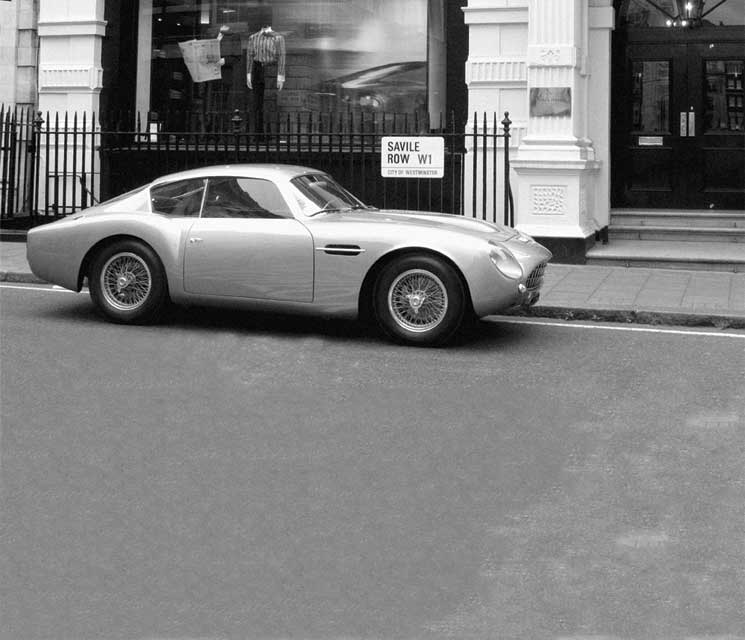
Two of the most valuable and collectable cars in Aston Martin's history - the DB4GT and DB4GT Zagato remain popular with Aston Martin owners and enthusiasts alike. With a combined volume of just 100 examples in total, these cars have fetched over £1m at auction. As pre-cursors to perhaps the most famous Aston Martin, the DB5, the DB4GT and DB4GT Zagato played a crucial role in defining some of the iconic design cues still used in by Aston Martin today
DB4GT
In October 1959, at the London Motor Show, an exciting new development of the DB4 was unveiled. With a shorter chassis, faired in headlamps and an uprated engine with 3 Weber carburettors, the DB4GT was designed to be equally at home on road and track.
The DB4GT was 85Kg lighter than the DB4 and was raced extensively with success by many famous drivers of the day. 75 ‘Touring’ bodied cars were built including several lightweight versions produced specifically for racing to demonstrate the car’s superb capabilities.
In October 1959, at the London Motor Show, an exciting new development of the DB4 was unveiled. With a shorter chassis, faired in headlamps and an uprated engine with 3 Weber carburettors, the DB4GT was designed to be equally at home on road and track.
The DB4GT was 85Kg lighter than the DB4 and was raced extensively with success by many famous drivers of the day. 75 ‘Touring’ bodied cars were built including several lightweight versions produced specifically for racing to demonstrate the car’s superb capabilities.
Price New: £ 4,534
Engine: DOHC Straight six, 3670 cc, 302 bhp @ 6000 rpm
240 lbs-ft @ 5000 rpm
Transmission: 4-speed manual DB
Suspension: Front: Telescopic shock absorbers and anti roll bar
Rear: double action lever arm shock absorbers
Brakes: Girling Servo assisted brakes with front and rear solid discs
Dimensions (LxWxH): 4353 x 1676 x 1321 mm
Weight: 1269 kg
Top Speed: 153 mph
Engine: DOHC Straight six, 3670 cc, 302 bhp @ 6000 rpm
240 lbs-ft @ 5000 rpm
Transmission: 4-speed manual DB
Suspension: Front: Telescopic shock absorbers and anti roll bar
Rear: double action lever arm shock absorbers
Brakes: Girling Servo assisted brakes with front and rear solid discs
Dimensions (LxWxH): 4353 x 1676 x 1321 mm
Weight: 1269 kg
Top Speed: 153 mph
DB4GT Zagato
In late 1960 the DB4GT Zagato was unveiled at the London Motor Show, clothed in a stunningly beautiful and lightweight body from the famous Italian coachbuilder. Only 19 examples were produced and this rarity is reflected in their high value today.
Four chassis numbers of the original proposed series remained unused and in 1991, four “Sanction 2” Zagatos, bodied in Italy and built by R.S.Williams Ltd in Cobham were produced with authorisation from the factory.
In late 1960 the DB4GT Zagato was unveiled at the London Motor Show, clothed in a stunningly beautiful and lightweight body from the famous Italian coachbuilder. Only 19 examples were produced and this rarity is reflected in their high value today.
Four chassis numbers of the original proposed series remained unused and in 1991, four “Sanction 2” Zagatos, bodied in Italy and built by R.S.Williams Ltd in Cobham were produced with authorisation from the factory.
Specifications
Price New: £ 5,470
Engine: DOHC Straight six, 3670 cc, 314 bhp @ 6600 rpm
240 lbs-ft @ 5000 rpm
Transmission: 4-speed manual DB
Suspension: Front: Telescopic shock absorbers and anti roll bar
Rear: double action lever arm shock absorbers
Brakes: Girling Servo assisted brakes with front and rear solid discs
Dimensions (LxWxH): 4353 x 1676 x 1321 mm
Weight: 1225kg
Top Speed: 153 mph
0 – 60 mph: 6.1 sec
Price New: £ 5,470
Engine: DOHC Straight six, 3670 cc, 314 bhp @ 6600 rpm
240 lbs-ft @ 5000 rpm
Transmission: 4-speed manual DB
Suspension: Front: Telescopic shock absorbers and anti roll bar
Rear: double action lever arm shock absorbers
Brakes: Girling Servo assisted brakes with front and rear solid discs
Dimensions (LxWxH): 4353 x 1676 x 1321 mm
Weight: 1225kg
Top Speed: 153 mph
0 – 60 mph: 6.1 sec
http://www.astonmartin.com/heritage-cars/db4gt#DB4GT
DB5 & DB5 CONVERTIBLE
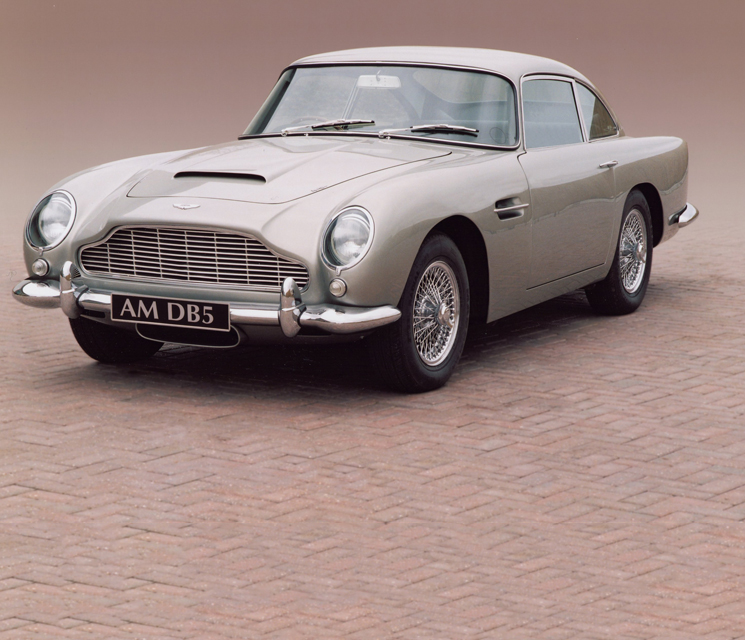
DB5
Often billed as the “most famous car in the world”, James Bond’s gadget laden Silver Birch DB5 in Goldfinger became many a schoolboy’s dream. Regarded by many as the most beautiful Aston Martin produced, the DB5 shares many similar traits to the DB4. However, DB5’s most substantial change occurred under the bonnet.
The engine capacity was enlarged to 4 litres by increasing the bore to 96mm. The car had three SU carburettors, as fitted to the outgoing DB4 Vantage, and also shared the latter’s fared in headlamps. Significant too was the introduction of a full synchromesh ZF 5 speed gearbox.
Enhancements

DB5 CONVERTIBLE
Compared to the DB4, chassis changes included the adoption of the Girling disc brakes that had only been used on the DB4GT, along with 15” wheels. Many other improvements were incorporated including electric windows and twin hydraulic brake servos.
A DB5 Vantage was offered with 3 Weber carburettors and different camshafts to offer a higher level of performance.
A Convertible was also offered which was available with an optional steel hard top. A small number of DB5s were built as ‘shooting brakes’, a sportsman’s interpretation of a modern ‘estate’ car, by coachbuilder Harold Radford.

Specifications:
Price New: £ 4,175 (Saloon), £ 4,490 (Convertible)
Engine: DOHC Straight six, 3995 cc, 382 bhp @ 5500 rpm
280 lbs-ft @ 4500 rpm
Transmission: 5-speed ZF box or optional Borg-Warner 3-speed automatic
Suspension: Front: Telescopic shock absorbers
Rear: Double acting lever arm shock absorbers
Brakes: Girling Twin servo assisted brakes with front and rear solid discs
Dimensions (LxWxH): 4570 x 1676 x 1320 mm (Saloon), 4480 x 1676 x 1322 mm (Convertible)
Weight: 1468kg
Top Speed: 142 mph
0 – 60 mph: 7.1 sec
www.astonmartin.com
Willys
1941
Willys Coupe
Willys Coupe "Champagne Dreams" 540 V8 625 HP
Willys Coupe
Willys Coupe "Champagne Dreams" 540 V8 625 HP
Aston Martin
1998
Aston Martin DB7
1998 Aston Martin DB7 Volante
Aston Martin DB7
1998 Aston Martin DB7 Volante
Labels:
1990-1999,
Aston Martin,
Convertible,
Hobby Segment Luxury,
Luxury,
Model DB7,
Passenger Car
Thursday, October 18, 2012
Porsche
1961
Porsche 356 B Super
Frame Off Restored Porsche 356B Super 1.6L 4 Speed
Porsche 356 B Super
Frame Off Restored Porsche 356B Super 1.6L 4 Speed
Subscribe to:
Posts (Atom)
.jpg)

